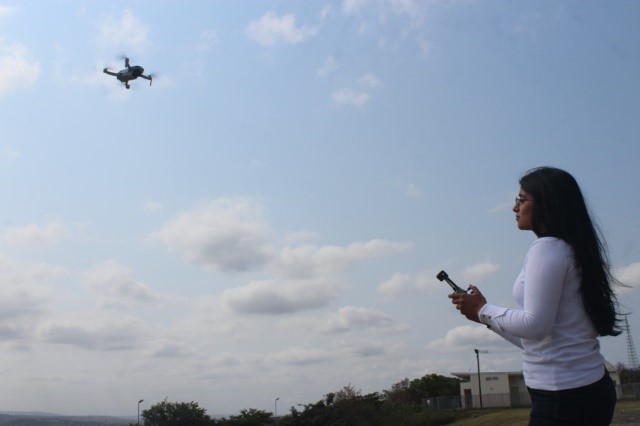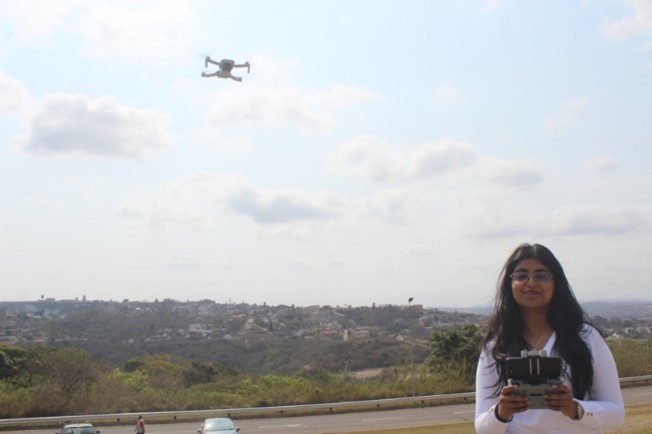Master’s Student Reaching for the Skies!


Breaking the glass ceiling is a phrase Ms Tasmiya Papiah is no stranger to! Currently completing her master’s degree under the supervision of Professor Kavilan Moodley and co-supervision of Dr Anthony Walters, Papiah’s research is focused on the analysis of drone beam mapping data from the HIRAX testbed array project.
With a focus on the HIRAX project within the School of Mathematics, Statistics and Computer Science, Papiah recently earned her remote pilot certificate for drones from the Starlite Aviation Training Academy in Virginia. The Hydrogen Real-time Analysis eXperiment (HIRAX), a radio interferometer array purpose built to measure the HI power spectrum, will eventually consist of 1024 6m dishes and will operate in the frequency range 400-800MHz. In order for HIRAX to achieve its science goals it will be critical to accurately characterise the spectral and angular response of the instrument (referred to as the ‘beam’).
Beam calibration of radio telescopes has traditionally been done using astronomical point sources. However, HIRAX dishes are not mounted motorised assemblies, meaning that they cannot be easily pointed, thus necessitating an alternative calibration strategy. The HIRAX collaboration is actively investigating the use of an artificial calibration source, in particular, a drone equipped with a noise transmitter. By flying the payload through the beam of the telescope, 2-dimensional beam, maps can be constructed. First flights at the testbed array are expected towards the end of the year.
Under the expert guidance of her training instructors Mr Craig Hansen, Mr Sheldon Butterfield, and Mr Brendon Stead of Starlite Aviation, Papiah completed the seven-week training course which kicked of with a restricted radio ground school, followed by a radio exam. Thereafter the course moved onto practical preparation, aimed at students familiarising themselves with the drone controls using the DJI simulator which is based on the DJI Phantom 4 pro drone. ‘The next phase was the radio practical course, which was particularly eye-opening. We learned about drone operations, navigation, energy management, air law, communication, operational procedures, flight planning, and even meteorology. It was a lot to take in, but it was fascinating,’ said Papiah.
Whilst she admits the course was no easy feat, the experience she gained during this time is invaluable to her. She is also extremely appreciative of the support and guidance provided to her by Smart Xchange who assisted with her funding application to the KZN Film Institute who funded the training. Papiah is particularly grateful to her instructors at Starlite Aviation for their constant encouragement and support.
With future plans of completing her PhD at UKZN, she is focused on submitting her master’s at the end of 2024. ‘I would like to thank SmartXchange and the KZN film commission for this opportunity and my supervisors, Prof Kavilan Moodley and Dr Anthony Walters, for allowing me to pursue this dream. I am truly grateful for their support.
‘Lastly, thank you to my family Shirahn, Reena and Tahani Papiah, for always encouraging me to keep going.’
Words: Prashina Ramcharan
Photograph: Ajith Sampath
Inspiring Greatness
© University of KwaZulu-Natal: All Rights Reserved






